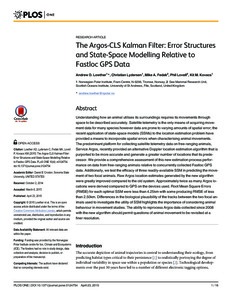The Argos-CLS Kalman Filter: Error Structures and State-Space Modelling Relative to Fastloc GPS Data.

View/
Average rating
votes
Date
2015Author
Lowther, A.D.
Lydersen, C.
Fedak, M.A.
Lovell, P.
Kovacs, K.M.
Metadata
Show full item recordAbstract
Understanding how an animal utilises its surroundings requires its movements through
space to be described accurately. Satellite telemetry is the only means of acquiring movement data for many species however data are prone to varying amounts of spatial error; the
recent application of state-space models (SSMs) to the location estimation problem have
provided a means to incorporate spatial errors when characterising animal movements.
The predominant platform for collecting satellite telemetry data on free-ranging animals,
Service Argos, recently provided an alternative Doppler location estimation algorithm that is
purported to be more accurate and generate a greater number of locations that its predecessor. We provide a comprehensive assessment of this new estimation process performance on data from free-ranging animals relative to concurrently collected Fastloc GPS
data. Additionally, we test the efficacy of three readily-available SSM in predicting the movement of two focal an.....
Journal
PLoS ONEVolume
10Issue
4Page Range
e012475 [16pp.]Document Language
enSustainable Development Goals (SDG)
SDG14Maturity Level
TRL 8 Actual system completed and "mission qualified" through test and demonstration in an operational environment (ground or space)Best Practice Type
ManualGuide
DOI Original
10.1371/journal.pone.01247Citation
Lowther, A.D.; Lydersen, C.; Fedak, M.A.; Lovell, P. and Kovacs, K.M. (2015) The Argos-CLS Kalman Filter: Error Structures and State-Space Modelling Relative to Fastloc GPS Data. PLoS ONE 10(4): e0124754. DOI:10.1371/journal.pone.0124754Collections
The following license files are associated with this item:
 Repository of community practices in Ocean Research, Applications and Data/Information Management
Repository of community practices in Ocean Research, Applications and Data/Information Management
